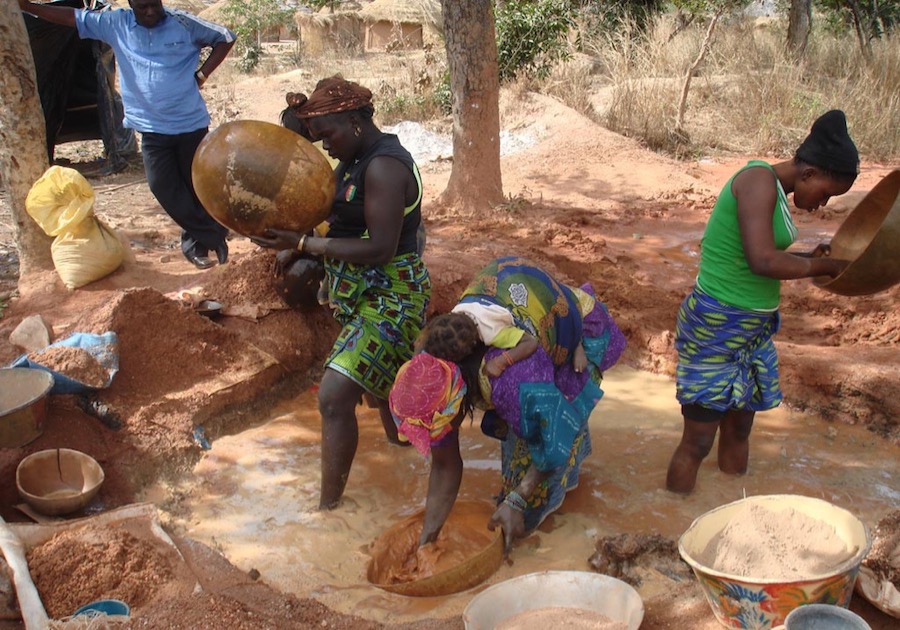
Gold mining in Africa has a bad rap — particularly when it comes to women. Depictions of the trade often focus on poverty, environmental destruction, prostitution and harassment. But in the gold mining belt of Mali, one of the world’s poorest countries, the victimization lens does great injustice to the hundreds of women mining alongside men.
Women working in the mines would be the first to say that the work is brutal and uncertain. When I spoke with some of them during a recent visit to Mali, they were clear about the dangers inherent in digging and moving piles of rocks in the hopes of finding a few grams of gold.
But the money they can make gives women financial autonomy and power that would be unimaginable if they remained in their villages to work on their husbands’ farms. Despite its flaws, low-tech artisanal mining empowers them in a way little else does.
It’s not simply that they need money and have few sources of it. It is the relational quality of the money they earn that matters. It is not their father’s or their husband’s; it is theirs own to keep, and that’s important in a place where women are still subordinate in the family and village units where they live.
Women make up around half the workforce in Mali’s artisanal gold mines, which is a similar participation rate to other parts of sub-Saharan Africa. In and around the mines of Kenieba, located in Mali’s southwestern corner, I encountered women from the neighboring countries of Burkina Faso, Senegal, and Guinea, where women’s land and labor rights are comparable to those of Mali. As West African women continue to seek work as gold miners, researchers and policymakers should seek to better understand and account for the linkages between land rights and artisanal mining as an emerging livelihood. This is especially true given that industrial gold mines, which generate most of Mali’s hard currency, create few jobs.
The mines themselves are no place for children. Yet many women venture to the gold mines with their babies in tow because the potential reward is so great, it trumps the risks. As one woman digging into a shallow pit of gravel told me: “Mining is more difficult than farming, but it pays a lot better.” Women are quick to add that agriculture is seasonal and money comes only once or twice per year while living expenses are ongoing. Despite government attempts to ban mining during the cropping season, people dig for gold in Kenieba all year round.
For many women miners in Mali, the ultimate goal is real estate. A parcel of land in their name that they can pass on to their own children is especially important in polygamous household where they may not be guaranteed a fair share of inheritance if their husband dies. If they strike it rich, they can build a rental property on their land and assure themselves of steady income that is difficult to achieve through farming.
Working with a Malian colleague, I recently conducted a survey of artisanal Kenieba miners and found that women who earn money mining gold are much less likely to have plans for a future in agriculture; unlike their male counterparts who often save up to buy agricultural machinery or to start up a livestock operation. Mining provides a potential escape route for women from land property relations that are still deeply unfavorable towards them. Climate change may be increasing the need for such an escape route as male farmers in the West African Sahel are beginning to displace their wives and female relatives from the land they traditionally cultivate, which tends to be in low-lying, more humid locations than their husbands’ fields.
Child marriage and poor educational prospects make for long odds, but for some young women who are not yet married, mining can act, over the course of a few months or years, as a pivot point towards a more independent livelihood. For women who divorce their husbands, which is increasingly common in Mali, mining provides a chance to avoid the penury and dependence that typically goes with leaving the in-laws’ household.
While a big step in the right direction, mining is not a perfect solution for women. Mali’s gold mines are still a man’s world. Ore is extracted by hand from mineshafts up to thirty meters deep and women invariably are excluded from those jobs and the better pay they bring. Women are, in fact, freelancers, keeping one basin out of 10 that they transport on the tops of their heads to the machines that extract the gold from the ore. Nonetheless, a lucky “treatment” can earn a woman $500 or more: a far cry from the dollar or two a day she may earn selling peanuts or fruit back home.
For many, earning money through artisanal mining provides a degree of emancipation from male-controlled, lineage-based land ownership. Global efforts to boost African agriculture tend to oversimplify these livelihood tradeoffs by relying on ineffective instruments, such as laws that fail to transform the everyday politics of getting by in rural Africa.
What women in Africa really need is for governments and their donors to recognize why so many of them take up mining and design their development strategies accordingly. Judging from the utter lack of development activity and choices for women in regions like Kenieba, mining is their best bet for financial freedom and opportunity. And for that reason, we all might want to look at it a little differently.
Leif Brottem, assistant professor of global development studies at Grinnell College, specializes in the role of geographic mobility within West African livelihoods.